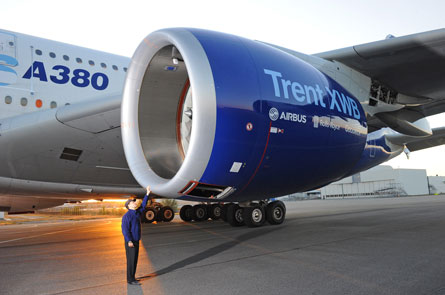Airbus has detailed its A350 main structural test campaign as it prepares to assemble the initial static airframe at Toulouse, ahead of full-scale testing in 2012.
A350 chief engineer Gordon McConnell said the fatigue test aircraft will be divided between three stations. EF1 will handle the nose sections 11, 12 and 13, while EF2 will deal with central sections 15-21, and 22, including the belly fairing and wing box. EF3 will focus on empennage sections 16-19, with a stub vertical fin.
The fatigue structures will include dummy parts for the nose and main landing gear, horizontal stabiliser and tail cone.
Airbus's first A350 in final assembly will be a static aircraft. Static testing will comprise the ES structure - a full airframe, fuselage and wing box, to provide data for first flight clearance as well as limit and ultimate load tests. A separate structure, EW, focused on the left-hand wing box, will be used for wing damage tolerance testing not performed on the ES rig, using 42 loading jacks.
 |
|---|
©Airbus |
EF1 will undertake 3,000 simulated flights a week. The EF2 rig - located in Erding, Germany, with the EW rig - will demonstrate fatigue of metallic parts, with simulated flights covering three design service goals. The EF3 rig is in Hamburg.
McConnell said more than 50% of the structures tests are running or have been completed as the airframer bids to ensure components achieve a high level of maturity, to reduce the risk of a lengthy programme overrun - particularly given that entry into service has already slipped to 2014.
Two development simulators have logged 300h since May, while the major integration benches and "iron bird" system for hydraulics and electrics assessment are also running.
The "iron bird" will be coupled with the simulators to create "Aircraft Zero". Integration tests for the high-lift system and landing gear have also started.
Five test examples of the Honeywell auxiliary power unit have completed more than 1,160h of tests, including some 3,200 starts, and APU icing certification tests have been completed. There is "good confidence" in the APU, said McConnell.
McConnell said more than 140 flight and ground tests - about 100 with Airbus's development jets, such as the A380 and A340, and the rest with supplier test aircraft - have been, or will be, performed to gain "early exposure" of A350 systems to flight conditions, before the type's flight tests.
Aircraft MSN1 will be the first flying prototype, and MSN3 will be a similar aircraft, while MSN2 will have a cabin fitted.
Among the crucial components sent to the final assembly line is the Rolls-Royce Trent XWB powerplant, delivered on 16 September. The engine for the A350-900 is the first in the Trent family to pass endurance testing first time, said the manufacturer.
Rolls-Royce has eight prototype engines, which have logged 1,200h of ground tests, and is preparing to carry out the first Trent XWB flights using a single example attached to an A380.
During a 150h regime, the engine was subjected to 17h operating at maximum red-line speeds and 42h at maximum continuous rating.
Trent XWB programme director Chris Cholerton said that for the last third of the test the manufacturer increased the temperatures, running the engine - intended to deliver 84,000lb (370Kn) thrust for the twinjet - at 91,300lb.
During strip-down and inspection of the components, the company discovered barely any damage except for some impact on a rotating seal - an issue which was easy to resolve, said Cholerton.
Cholerton said Rolls-Royce had looked at "every disruptive event" in the Trent family to "check that none of the known existing service issues is present" in the XWB.
He added that the compressor had been "exceeding expectation" and the performance of the engine had allowed the manufacturer to simplify the design - such as replacing a set of rotating vanes with static ones.
Early performance results gave Rolls-Royce the leeway to raise the thrust capability of the engine to 97,000lb, an increase at the heart of the A350-1000 redesign, detailed earlier this year, which lifted the type's payload-range and maximum take-off weight.
McConnell revealed that other major changes to the -1000 had been considered, including a smaller vertical fin and a mini trailing-edge device for the flaps, but said these had been "dropped". However, other alterations have been adopted: the main landing-gear beam attachment had been "optimised" and the ram-air turbine moved slightly aft.
Redesign of the -1000 has not satisfied two of its four customers - Dubai-based Emirates and Doha-based Qatar Airways - but Airbus reiterated during the Dubai air show that it would not alter the design again.
"Our opinion on the -1000 remains the same. We are not happy," said Qatar chief Akbar Al Baker, who even suggested Airbus would rethink the configuration.
But Airbus chief operating officer for customers, John Leahy, dismissed the idea. "We clearly need to get a sales team to Doha to explain the aircraft," he said.
McConnell said: "We have a great aircraft that can fly anywhere in the world. We're not going to change it."
Source: Flight International























